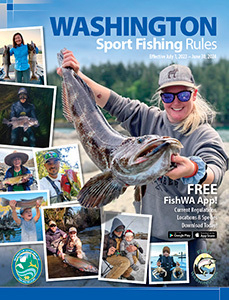Shellfish/Seaweed Species Rules
For more detailed information about shellfish, please visit |
|||
Area |
Species |
Season |
Additional Rules |
Abalone |
|||
All Areas |
Pinto |
Closed |
Surveys show a continued decline in numbers of all size abalone. The closure is necessary to allow recovery of stocks. Abalone have been listed as an endangered species. |
Clams, Other Than Razor Clams |
|||
Always check the local biotoxin status before harvesting via the biotoxin hotline (1-800-562-5632) or www.doh.wa.gov/shellfishsafety. Biotoxins can present hazards in any clam species, and butter and varnish clams can retain elevated levels of biotoxins for extended periods. Clams can be dug by hand or hand-operated fork, pick, rake, or shovel. Each digger must use a separate container. Digging equipment may be shared. The tide and waves do not quickly refill holes created by harvesters. Unfilled harvesting holes and sediment piles can damage clam habitat and kill clams. Clam harvesters must refill holes created while digging. To reduce clam mortality, please push any undersized or discarded clams into the refilled holes. Harvesting seasons vary by beach. See year-round harvest closures and advisories on Shellfish Safety Information and area closures on Marine Preserves, Conservation Areas and Shellfish Protection Zones. |
|||
Public Beaches |
Geoducks |
See Shellfish/Seaweed Regulations for season information |
No min. size. Daily limit first 3 dug. It is unlawful to thrust any instrument through the neck of a geoduck. It is unlawful to possess only the neck of a geoduck. Geoduck cylinder max diameter is 24" and must be non-mechanized and hand-operated. |
Horse Clams |
No min. size. Daily limit first 7 dug regardless of size or condition (broken clams count towards limit). |
||
All Other Species (Listed Below) |
Daily limit no more than 40 clams, not to exceed 10 lbs. in the shell, all species combined (excluding horse clams and geoducks). For species with a minimum size, measure across longest distance of shell. |
||
Native Littlenecks |
Min. size 1½". |
||
Manilas |
Min. size 1½". |
||
Butters |
Min. size 1½". |
||
Cockles |
Min. size 1½". |
||
Eastern Softshells |
No min. size. |
||
Varnish |
No min. size. |
||
All Other Marine Clams |
No min. size. |
||
All Fresh Water Areas |
All Species |
Closed |
|
Manila Littleneck Clam
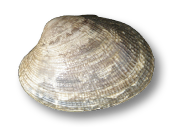
Venerupis philippinarum
Average size is 1-2", up to 2½". Oval elongated shell has concentric and radiating lines. Siphon tips are split. Found to 4" below surface.
(Eastern) Softshell Clam
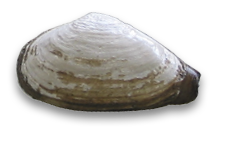
Mya arenaria
Can grow to 6". Shells are soft, chalky-white with a rough irregular surface. Shell is rounded at the foot end, pointed at the siphon end. Siphon doesn't have leather-like flap on the tip. Found to 18" below surface. Unable to rebury on its own. Push into refilled hole siphon side up.
Native Littleneck Clam
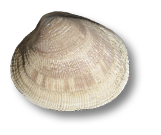
Leukoma staminea
Average size is 1-2", up to 2½". Rounded shell has concentric and radiating lines. Siphon tips are fused. Found 6-10" below surface.
Varnish Clam
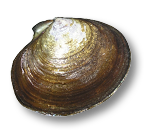
Nuttallia obscurata
Up to 3", with shiny brown coating on the outside, purple on the inside of shell. Found 3-12" below the surface.
Cockle Clam
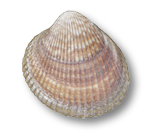
Clinocardium nuttallii
Prominent, evenly-spaced ridges which fan out from the hinge. Mottled, light brown. Can grow to 5". Found on or just below surface.
Horse Clam

Tresus nuttallii (shown)
Tresus capax (not shown)
Large, can grow up to 8". Shell is chalky-white with yellow-brown patches of "skin". The siphon can't be pulled into shell and has a leather-like flap on the tip. Found 1-2 feet below surface. Unable to rebury on its own. Push into refilled hole siphon side up.
Butter Clam
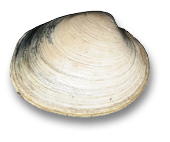
Saxidomus giganteus
Average size is 3-4", up to 6". Shells have no radiating lines and are usually chalky-white or stained blue. The siphon can be pulled into its shell. Usually found 12-18" below surface. Shell gapes slightly at siphon. Unable to rebury on its own. Push into refilled hole siphon side up.
Geoduck Clam
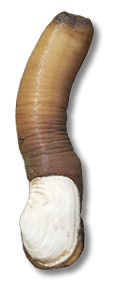
Panopea generosa
Heavy, oblong shell, rounded at one end. Appears cut-off at the other. The siphon has no leather-like flap on the tip and can't be pulled into the shell. Found 2-3 feet below surface. Can weigh up to 10 lbs. Unable to rebury on its own.
Area |
Species |
Season |
Additional Rules |
Crab |
|||
See Crab Rules for crab harvest information and Statewide Gear Rules for crab gear rules. |
|||
Crayfish (Crawfish) |
|||
All Open Waters |
Native Species |
1st Mon. in May-Oct. 31 |
Min. size 3¼" from tip of rostrum (nose) to tip of tail. Daily limit 10 lbs in shell. All females with eggs or young attached must be immediately returned to the water unharmed. No Shellfish/Seaweed license is required. See Statewide Gear Rules. |
Nonnative Species |
1st Mon. in May-Oct. 31 |
Must be kept in a separate container. Must be dead before being removed from riparian area (immediate vicinity of water body). No daily limit, size, or sex restrictions. No Shellfish/Seaweed license is required. See Statewide Gear Rules. |
|
There is only one native crayfish species in Washington — the signal crayfish (Pacifastacus leniusculus). This species can be identified by its uniform brownish coloration, white or light coloration of the claw joint ,and the smooth surface of its carapace and claws compared to that of nonnative species. Native crayfish are the only crayfish that may be removed from the vicinity of the waterbody alive. If you cannot positively identify your catch as a nonnative species, the daily limit and other restrictions listed above for native crayfish apply. 
How to humanely kill and preserve crayfish: There are two important steps to killing a crayfish quickly and humanely. The first is to chill them in ice or ice slurry for 20-30 minutes, and the second is to pierce their head with a knife. |
|||
Goose Barnacles |
|||
Caution: for Shellfish Safety and Department of Health contact information see Shellfish Safety Information. |
|||
Puget Sound Public Beaches |
Year-round |
No min. size. Daily limit 10 lbs. whole or 5 lbs. barnacle stalks. See closures on Marine Preserves, Conservation Areas and Shellfish Protection Zones. |
|
Pacific Ocean Beaches (Outside Olympic National Park) |
Nov. 1-Mar. 31 |
No min. size. Daily limit 10 lbs. whole or 5 lbs. barnacle stalks. |
|
Mussels |
|||
Seasons in Puget Sound are the same as clam seasons on each beach. Harvesting seasons vary by beach. Caution: for Shellfish Safety and Department of Health contact information see Shellfish Safety Information. |
|||
Puget Sound Public Beaches |
Blue, California, Mediterranean |
See Marine Area 12 for season information |
No min. size. Daily limit 10 lbs. in shell. See year-round harvest closures and advisories on Shellfish Safety Information and area closures on Marine Preserves, Conservation Areas and Shellfish Protection Zones. |
Pacific Ocean Beaches (Outside Olympic National Park) |
Blue, California, Mediterranean |
Nov. 1-Mar. 31 |
No min. size. Daily limit 10 lbs. in shell. |
All Fresh Water Areas |
All Species |
Closed |
|
Octopus |
|||
Must be caught with hands or instrument which does not penetrate the octopus. May be caught incidentally using shellfish pot gear during a lawful shellfish pot fishery or hook and line gear during a lawful hook and line fishery. Chemical irritants cannot be used to take octopus. For Octopus Protection Areas see |
|||
All Waters except Marine Area 12, Marine Preserves, Conservation Areas, and Octopus Protection Areas |
Giant Pacific |
Year-round |
No min. size. Daily limit 1. No chemicals or irritants allowed. See closures on Marine Preserves, Conservation Areas and Shellfish Protection Zones. |
Marine Area 12, Marine Preserves, Conservation Areas, and Octopus Protection Areas |
All Species |
CLOSED |
See closures on Marine Preserves, Conservation Areas and Shellfish Protection Zones. |
Oysters |
|||
Caution: for Shellfish Safety and Department of Health contact information see Shellfish Safety Information. Oysters may only be harvested by hand or with a hand-held manually operated prying tool (no hammers, etc.). Each harvester must use a separate container. Harvesting seasons vary by beach. See year-round harvest closures and advisories on Shellfish Safety Information and area closures on Marine Preserves, Conservation Areas and Shellfish Protection Zones. |
|||
Public Beaches |
All Species |
See Shellfish/Seaweed Regulations for season information |
Min. size 2½" measured across longest distance of shell. Daily limit 18. Oysters must be shucked on the beach. Oysters consumed on the beach count toward a limit. Leave shells on the same tideland and tide height where they were taken. |
Area |
Species |
Season |
Additional Rules |
Relic Shells |
|||
All Areas |
All Species |
Year-round |
Daily limit is 5 pounds of all species combined. Take of oyster shells is prohibited. Removal of shells on State Park beaches prohibited. No license required. See Don't Relocate Shells or Shellfish! information on Shellfish Safety Information. |
Sand Shrimp |
|||
Public Beaches |
All Species |
Year-round |
No min. size. Daily limit 10 dozen. May be harvested only by hand or by hand-operated suction devices. See closures on Marine Preserves, Conservation Areas and Shellfish Protection Zones. |
Scallops |
|||
Biotoxin Warning: Scallops may retain elevated levels of marine biotoxins. Currently, Department of Health lists all areas closed for the recreational harvest of scallops due to biotoxins. Check the Department of Health Biotoxin Hotline (800) 562-5632 or |
|||
All Waters |
Pink and Spiny |
Year-round |
Min. size 2" measured across longest distance of shell. Daily limit 40, combined limit for both species. May be harvested only by hand or with a hand-held manually operated prying tool. |
Weathervane |
Year-round |
Min. size 4". Daily limit 12. Measure across longest distance of the shell. |
|
Rock |
Year-round |
No min. size. Daily limit 6. Hammers or mallets may not be used to harvest rock scallops. |
|
Sea Cucumbers |
|||
Caution: for Shellfish Safety and Department of Health contact information see Shellfish Safety Information. See closures on Marine Preserves, Conservation Areas and Shellfish Protection Zones. Marine areas subject to seasonal/conservation closures, check the latest emergency rules at |
|||
All Waters except for Marine areas 8-1, 8-2, 9, 10, and 12 detailed below |
California |
July 1-last day in Feb. |
No min. size. Daily limit 18. All other sea cucumber species are unclassified marine invertebrates and may not be harvested. See rules for unclassified marine invertebrates (below). |
Marine area 8-1 |
All Species |
Closed |
|
Marine area 8-2 |
All Species |
Closed |
|
Marine area 9 south of a line projected from Foulweather Bluff to Double Bluff |
All Species |
Closed |
|
Marine area 10 |
All Species |
Closed |
|
Marine area 12 |
All Species |
Closed |
|
Sea Urchins |
|||
See closures on Marine Preserves, Conservation Areas and Shellfish Protection Zones. |
|||
All Waters except Marine area 12 |
Green |
Year-round |
Min. size 2 ¼" measured across longest distance of shell, not including spines. Daily limit 18. |
Purple |
Year-round |
Min. size 2 ¼" measured across longest distance of shell, not including spines. Daily limit 18. |
|
Red |
Year-round |
Min. size 3 ¼" and max. size 5" measured across longest distance of shell, not including spines. Daily limit 18. |
|
White |
Year-round |
Closed |
|
Marine Area 12 |
All Species |
Year-round |
Closed |
Seaweed |
|||
(Many county and city parks have additional rules or closures. Please check local regulations before harvesting). Wash all seaweed before eating. |
|||
All Areas |
All Species |
Year-round |
Daily limit 10 lbs. wet weight. Illegal to harvest any seaweed if herring eggs are attached. |
All State Park beaches are closed to seaweed harvest except Fort Flagler, Fort Ebey, and Fort Worden State Parks, which are open to seaweed harvest from April 16-May 15 only. Seaweed harvesting in State Parks is limited to posted park hours and special State Park rules below:
|
|||
Shrimp |
|||
See Shrimp Rules for shrimp harvest and gear rules. |
|||
Squid |
|||
Legal gear is a forage fish jig, a maximum of 4 squid lures, forage fish dip net, or a handheld dip net. Each harvester must have a separate container. See closures on Marine Preserves, Conservation Areas and Shellfish Protection Zones. |
|||
All Waters |
Market Squid and all other species |
Year-round |
No min. size. Daily limit is 5 qts. or 10 lbs. |
Humboldt Squid |
Year-round |
Daily limit is 5 squid. |
|
Unclassified Marine Invertebrates |
|||
All Areas |
All Species |
Closed |
See definition. Examples below. |
Japanese Oyster Drill Snail

A voracious, invasive predator of marine bivalves. Shell up to 1½" with ornate ridges. Snail and yellow/orange egg capsules commonly attached to shells and living oysters. It is unlawful to transfer this species or its eggs from one beach to another; it is also unlawful to transfer any shellfish or shells from one beach to another without a permit. See “Don’t Relocate Shells or Shellfish!” on Shellfish Safety Information.
Native Oyster Drill Snail

Sand Dollar

Sea star, sand dollar, Pacific graceful and shore crabs photos courtesy of Wendy Feltham.
Moon Snail

Shore Crab


Kelp Crab

Pacific Graceful Crab

Sea Star


